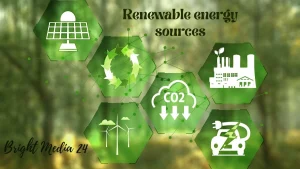Global warming is a major issue not only for our country but for all countries, and it is continuously increasing in the Earth’s atmosphere. Due to this problem, not only humans but every living creature on Earth is being harmed. Every country is taking continuous steps to address this issue. However, instead of decreasing, global warming is steadily increasing. Humans are the biggest culprits of global warming. Our activities are causing a continuous increase in global warming everywhere. Due to these human activities, the amount of greenhouse gases such as carbon dioxide, methane, nitrogen oxide, etc., which are harmful gases to the environment, is increasing compared to the amount of greenhouse gases.
Definition of Global Warming:
Global warming refers to the increase in the Earth’s environmental temperature worldwide.
Concept of Global Warming:
Global warming refers to the sustained increase in the average temperature of the Earth’s atmosphere and oceans since the 20th century. Over a span of 2500 years, the average temperature of the Earth’s atmosphere near its surface has increased by approximately 0.74 ± 0.8 °C (1.33 ± 0.32 °F).
Natural Causes of Global Warming:
The main responsible factors for changes in water and air due to global warming are greenhouse gases. Greenhouse gases are those gases that trap heat or absorb heat from outside. Carbon dioxide is the most important greenhouse gas. It is released into the atmosphere by living beings, including humans. According to environmental scientists, the amount of carbon dioxide in the Earth’s atmosphere is increasing, which results in an increase in temperature in the atmosphere. If the emission of these gases continues in the same way, according to scientists, the temperature of our Earth can rise by 3 to 8 degrees Celsius (5.4 to 14.4 degrees Fahrenheit) by the 21st century. If such a scenario occurs, the consequences will be devastating. Snow blankets will disappear in many parts of the world. The sea level will rise, causing many areas of the world to be submerged in water. It will be more catastrophic than any global war or collision with any “celestial body.” It will prove to be very harmful to our Earth.
Human Causes of Global Warming:
The majority of the factors responsible for global warming are created by humans, resulting in destructive consequences. In the race for progress and development, humans are moving away from nature. Rivers and streams are being obstructed. Trees and forests are being destroyed to gather our happiness and resources. Due to the industrial revolution, coal, oil, and millions of vehicles are producing excessive pollution, causing our Earth to become abnormally warm. Other human-made causes of global warming include:
1. Deforestation
Unplanned deforestation is happening due to population growth and industrialization. Forests are indiscriminately cut down to expand agricultural land, thus increasing the issue of global warming.
2. Industrialization
The United Nations panel had issued a warning that continuous emissions of greenhouse gases will lead to an increase in global temperature, resulting in changes in every aspect of the climate system. It will also cause heavy toxic smoke from industries, which is leaving deep impacts on global warming.
3. Urbanization
Due to urbanization, the use and encroachment of land are increasing, leading to changes in the cycles of seasons and an increase in temperature, which is global warming.
4. Various Human Activities
Human-made activities and environmental degradation are causing the emergence and spread of diseases like Dengue, Anthrax, Anaplasmosis, COVID-19 etc, which is proving to be a contributor to global warming.
5. Increase in Harmful Emissions
Many harmful pollutants contribute to global warming. These include nitrogen oxides, methane, water vapors, chlorofluorocarbons, and more. The continuous increase in their production contributes to global warming.
6. Use of Chemical Fertilizers
Farmers use various chemical fertilizers to enhance agriculture. Proper precautions should be taken while using them, but many people misuse them. As a result, the level of human benefits is continuously decreasing, and due to a decrease in their usage, global warming is being created.
7. Developed Countries are Responsible for Global Warming
One of the causes of global warming is developed countries. Their behavior is continuously causing disruption. The emission rate of carbon in their countries is 10 times higher than developing countries. However, they are not willing to reduce carbon emissions to sustain their industrialized nature. On the other hand, countries like India, China, and Japan believe that they are also in the process of development, so they cannot go on the path of reducing carbon emissions. Therefore, even developed countries should work with a little harmony and understanding the safety of their Earth.
8. Renewable energy sources
Renewable energy sources have emerged as a crucial solution in combating the environmental challenges posed by traditional fossil fuels. These sources, such as solar, wind, hydro, geothermal, and biomass, harness the power of natural elements that can be replenished and do not deplete the Earth’s resources. One of the most prominent advantages of renewable energy sources is their significantly lower carbon footprint compared to fossil fuels. By relying on these clean energy alternatives, we can reduce greenhouse gas emissions and mitigate the impact of climate change.
a) Solar energy
Solar energy, obtained from sunlight, has become increasingly accessible with advancing technology. It is utilized through photovoltaic panels and solar thermal systems to generate electricity and heat water for various applications. Likewise, wind power harnesses the kinetic energy of moving air to generate electricity using wind turbines. Wind farms are being installed across the globe, taking advantage of windy regions to produce a sustainable and abundant energy supply.
b) Hydropower
Hydropower, another renewable energy source, relies on the force of flowing or falling water to generate electricity. It has been widely adopted through the construction of dams and hydroelectric power plants, providing a reliable and constant source of clean energy. Additionally, geothermal energy taps into the Earth’s internal heat to produce electricity and heat homes, making use of the thermal energy stored beneath the Earth’s surface.
c) Biomass energy
Biomass energy derives from organic matter such as wood, crop residues, and animal waste. It can be converted into biofuels or burned directly for heat and electricity production. Biomass serves as a valuable energy source, especially in rural areas where agricultural waste is abundant, reducing reliance on non-renewable fuels and contributing to waste management.
Recommendations:
Global warming is a human-made phenomenon because no change occurs without human intervention. Therefore, just as we are causing global warming, we need to come together as humans to save this Earth from global warming. In other words, we need to see its alarming form, where the existence of the Earth itself will be in danger. Thus, humans need to think about it with harmony, intelligence, and unity, or else finding a solution is inevitable. Otherwise, the same oxygen that sustains our breaths will cease to exist due to those dangerous gases. Hence, prioritizing ecological betterment over technological and economic stability is of utmost importance.




